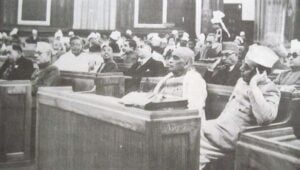The system of Dyarchy, also spelled diarchy, was a system of double government introduced by the Government of India Act (1919) for the provinces of British India. It marked the first introduction of the democratic principle into the executive branch of the British administration of India.
Under Dyarchy, the provincial executive was divided into two parts: reserved subjects and transferred subjects. Reserved subjects, such as law, order, finance, and land revenue, remained under the control of the Governor, who was appointed by the British Crown. Transferred subjects, such as education, public health, and local government, were transferred to the control of Indian ministers who were elected by the Provincial Legislature.
The Governor had the power to veto any legislation passed by the Provincial Legislature, and he could also override the decisions of the Indian ministers. This meant that the British government still retained ultimate control over the provinces, even though the Indian ministers had some say in the administration of transferred subjects.

Constitutional Assembly | Credit: Wikimedia Commons
The Dyarchy system was much-criticised by both Indian nationalists and British conservatives. Indian nationalists argued that it did not go far enough in transferring power to Indians. British conservatives argued that it was too risky to give Indians control over any part of the government.
Despite its critics, the dyarchy system was a significant step towards Indian self-government. It gave Indians their first experience of governing themselves, and it helped to develop the skills and experience that would be needed for independent rule.
The Dyarchy system was abolished by the Government of India Act (1935), which introduced provincial autonomy. Under provincial autonomy, the provinces were given full control over all subjects, except for defence, foreign affairs, and communications.
The Dyarchy system was a complex and imperfect system of government, but it was an important milestone in the history of Indian independence. It marked the beginning of the transfer of power from British to Indian hands.
Continue to the next section: The Last Constitution of British India
